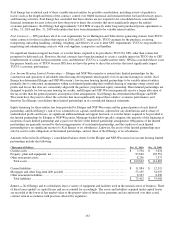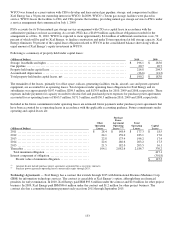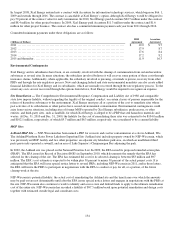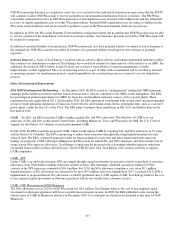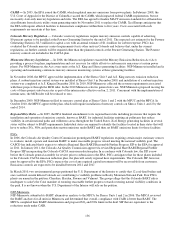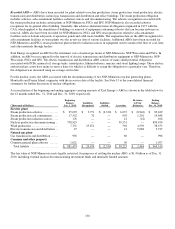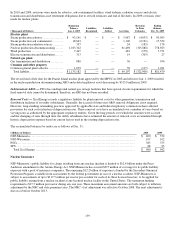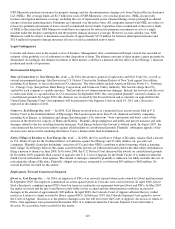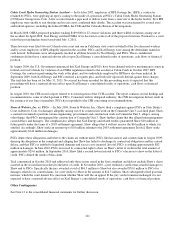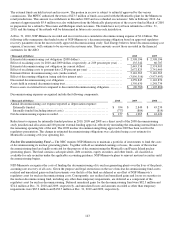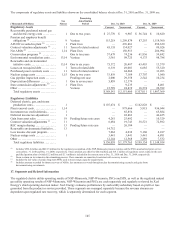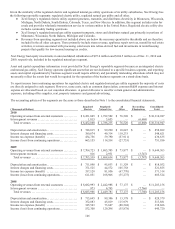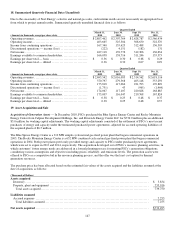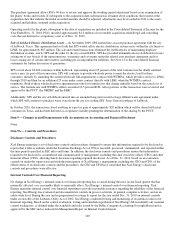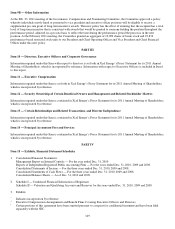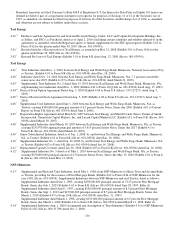Xcel Energy 2010 Annual Report Download - page 152
Download and view the complete annual report
Please find page 152 of the 2010 Xcel Energy annual report below. You can navigate through the pages in the report by either clicking on the pages listed below, or by using the keyword search tool below to find specific information within the annual report.142
15. Nuclear Obligations
Fuel Disposal — NSP-Minnesota is responsible for temporarily storing used or spent nuclear fuel from its nuclear plants. The
DOE is responsible for permanently storing spent fuel from NSP-Minnesota’s nuclear plants as well as from other U.S. nuclear
plants. NSP-Minnesota has funded its portion of the DOE’s permanent disposal program since 1981. The fuel disposal fees are
based on a charge of 0.1 cent per KWh sold to customers from nuclear generation. Fuel expense includes the DOE fuel disposal
assessments of approximately $13 million in 2010, $12 million in 2009 and $13 million in 2008, respectively. In total, NSP-
Minnesota had paid approximately $410.7 million to the DOE through Dec. 31, 2010. The Nuclear Waste Policy Act of 1982
required the DOE to begin accepting spent nuclear fuel no later than Jan. 31, 1998. NSP-Minnesota and other utilities have
commenced lawsuits against the DOE to recover damages caused by the DOE’s failure to meet its statutory and contractual
obligations.
NSP-Minnesota has its own temporary on-site storage facilities for spent fuel at its Monticello and Prairie Island nuclear plants,
which consist of storage pools and dry cask facilities at both sites. The amount of spent fuel storage capacity currently authorized
by the NRC and the MPUC will allow NSP-Minnesota to continue operation of its Prairie Island nuclear plant until the end of its
renewed licenses terms, when approved by the NRC in 2011, and its Monticello nuclear plant until the end of its renewed
operating license in 2030. Other alternatives for spent fuel storage are being investigated until a DOE facility is available,
including pursuing the establishment of a private facility for interim storage of spent nuclear fuel as part of a consortium of
electric utilities.
Regulatory Plant Decommissioning Recovery — Decommissioning of NSP-Minnesota’s nuclear facilities is planned for the
period from cessation of operations through 2067, assuming the prompt dismantlement method. NSP-Minnesota is currently
recording the regulatory costs for decommissioning over the MPUC-approved cost-recovery period and including the accruals in
a regulatory liability account. The total decommissioning cost obligation is recorded as an ARO in accordance with the applicable
accounting guidance.
Monticello received its initial operating license in 1970 and began commercial operation in 1971. With its renewed operating
license and CON for spent fuel capacity to support 20 years of extended operation, Monticello can operate until 2030. The
Monticello 20-year depreciation life extension until September 2030 was granted by the MPUC in 2007. Construction of the
Monticello dry-cask storage facility is complete, and 10 of the 30 canisters authorized have been filled and placed in the facility.
Prairie Island Units 1 and 2 received their initial operating license and began commercial operations in 1973 and 1974,
respectively, and are currently licensed to operate until 2013 and 2014, respectively. In April 2008, NSP-Minnesota filed an
application with the NRC to renew the operating license of its two nuclear reactors at Prairie Island that will allow operation for
an additional 20 years until 2033 and 2034, respectively. The NRC staff is proceeding with the remaining items necessary to
process Prairie Island’s license renewal application and NSP-Minnesota anticipates receiving a final decision on the Prairie Island
license renewal in 2011. Prairie Island’s depreciation life, as approved by the MPUC in June 2010, is currently 2024. The Prairie
Island dry-cask storage facility currently stores 29 casks to support operations until the end of the current operating licenses in
2013 and 2014. The MPUC approved the use of 35 additional casks to support operations until the end of the renewed operating
licenses (once received from the NRC) in 2033 and 2034.
The total obligation for decommissioning currently is expected to be funded 100 percent by the external decommissioning trust
fund, as approved by the MPUC, when decommissioning commences. The MPUC last approved NSP-Minnesota’s nuclear
decommissioning study request in October 2009, using 2008 cost data. The next study update will be submitted in October 2011
for the 2012 accrual. The MPUC approval eliminated 2009 decommissioning funding for Minnesota retail customers, due to a full
extension of the accrual period for the Monticello unit from 2020 to 2030, along with an extension of the accrual period for
Prairie Island (from 2013 for Unit 1 and 2014 for Unit 2 to 2023 and 2024 respectively). In November 2009, the MPUC also
approved a proposal to refund the Minnesota portion of the Monticello escrow fund in a supplemental filing.
Consistent with cost-recovery in utility customer rates, NSP-Minnesota previously recorded annual decommissioning accruals
based on periodic site-specific cost studies and a presumed level of dedicated funding. Cost studies quantify decommissioning
costs in current dollars. The most recent study, which resulted in an authorization of no funding, presumes that costs will escalate
in the future at a rate of 2.89 percent per year. The total estimated decommissioning costs that will ultimately be paid, net of
income earned by the external decommissioning trust fund, is currently being accrued using an annuity approach over the
approved plant-recovery period. This annuity approach uses an assumed rate of return on funding, which is currently 6.30 percent,
net of tax, for external funding. The net unrealized loss on nuclear decommissioning investments is deferred as a regulatory
liability based on the assumed offsetting against decommissioning costs in current ratemaking treatment.


